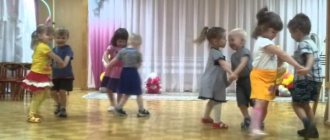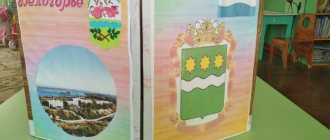“Musical interactive games in educational and musical play activities of preschool children”
Musical interactive games in educational and musical play activities of preschool children.
Muss Yulia Vladimirovna,
musical director.
Working in a modern preschool educational institution requires the music director to use new technologies aimed at effectively assimilating by children the content of educational programs in the conditions of the Federal State Educational Standard, which contributes to the formation of a person in modern society. To make educational activities more interesting and rich for a child, it is necessary to give children the opportunity to take an active part in the process of learning and creativity. In the context of informatization of preschool education, new opportunities are opening up for the development of methods and organizational forms of music education. Today it is difficult to surprise anyone with the presence of a computer, interactive whiteboard or multimedia projector in kindergarten. This technique is already becoming a necessary and indispensable means of improving the quality of the educational process. Innovations in the work of preschool educational institutions using interactive technologies increase the interest and attention of preschoolers. That is why interactive musical games on various topics can be introduced into the educational process with children.
Interactive games are an information and communication tool aimed at preschooler activities that take place online. Along with traditional teaching methods, such as the use of didactic games, multimedia interactive games allow children to become acquainted with new material with particular interest, consolidate previously learned material, and also contribute to developing children’s logical thinking in the most accessible and attractive form of play, strengthening the creative component of learning. process.
Features of interactive games:
using a variety of ways to present information
(graphics, animation, video and sound);
organization of interactive interaction between the child and the computer, providing support for independent educational and cognitive activity;
organization of group educational activities using information and communication technologies;
the use of interactive games in educational and leisure activities, in kindergarten and at home.
The interactive games presented by the teacher meet various educational and educational objectives:
development of speech activity;
development of motor activity;
knowledge of the surrounding world;
formation of creative initiative, including musical.
Musical interactive games are multimedia games, during which the student develops rhythmic hearing, musical perception, and gets acquainted with various types of musical genres, which helps enrich the child’s vocabulary with musical terms. In music classes and in leisure time, you can use computer educational and educational games aimed at a particular age of preschoolers, thereby arousing interest in this educational area and developing the creative and intellectual abilities of children. An interesting soundtrack and bright graphics open up new didactic opportunities for children related to the visualization of material, its “revitalization,” the ability to visualize those phenomena and processes that cannot be demonstrated in other ways. The advantage of musical, didactic and interactive games is that the child can independently take part in the game. Having launched the game, the preschooler completely follows its audio instructions, which will correct mistakes at the right time and reward them for successfully completing the task.
Consultation for parents “Computer games for developing children’s musical abilities”
Mlada Sidorova
Consultation for parents “Computer games for developing children’s musical abilities”
Consultation for parents “Computer games to develop children’s musical abilities”
The predominant thinking in a child is the right hemisphere (emotionally - figurative). It is characterized by brightness of perception, visual, figurative memory, richness of imagination and some insufficiency of abstract thinking. Therefore, introducing a child into the atmosphere of art should be unexpected, mysterious, and exciting. And the game becomes the leading activity of children. It is through play that preschoolers learn.
We all know that computerization has widely entered our lives, and has made its way into preschool education. She could not ignore the musical development of preschoolers. Nowadays, a lot of musical and didactic games have appeared in the multimedia space to develop children’s musical abilities.
Musical-didactic games combine all types of musical activities of children: singing, listening, musical-rhythmic movements, exercises in the form of games. Musical and didactic games have two functions in the learning process. The first function is to improve and consolidate knowledge. At the same time, the child does not simply reproduce knowledge in the form in which it was learned, but transforms, transforms it, learns to operate with it depending on the game situation. The essence of the second function of the didactic game is that children acquire new knowledge and skills of different content. Musical and didactic games enrich children with new impressions, develop their initiative, independence, ability to perceive, and distinguish the basic properties of musical hearing.
I would like to emphasize that not all innovative games are equally good in the musical development of preschoolers. We have prepared for you examples of musical and didactic games using information technology to develop children's musicality:
1. Teremok : https://www.youtube.com/watch?v=9LeRedQupN8
Purpose of the game: development of auditory attention and understanding of the figurative content of music.
Game content:
Children listen to music and try to determine by the nature of the sound which of the heroes of the fairy tale is going to the tower. A character picture appears on the screen
2. Musical flowers: https://www.youtube.com/watch?time_continue=1&v=6X6gTlKqmJQ
Purpose of the game: distinguishing character, mood of music, development of the emotional sphere
Game content:
Children listen and determine the nature of the music and choose a flower that matches the mood.
3. Song, dance, march: https://www.youtube.com/watch?time_continue=1&v=PD5F5iIylgQ
Goal: learn to distinguish between 3 main genres of music
Game content:
Children listen to musical fragments and determine the genre, choose the corresponding image
4. Three Bears: https://www.youtube.com/watch?v=ZAXTgFY0vss
Goal: learn to distinguish the timbre and tempo of music
Game content:
Children watch an excerpt from a cartoon and remember its characters. Then, by the timbre of the music and the tempo of the steps, they will find out which of the 3 bears has arrived
5. Musical Christmas tree: https://www.youtube.com/watch?time_continue=1&v=wBjzDgj0QZE
Goal: consolidate knowledge of basic musical instruments
Game content:
Musical instruments were hidden behind each Christmas tree decoration. Children listen and identify each instrument by its sound; a picture answer comes down from the tree.
6. Who did the bun meet? https://www.youtube.com/watch?time_continue=1&v=vqaRDVTa6II
Purpose of the game: development of auditory attention and understanding of the figurative content of music.
Game content:
Children listen to music and try to determine by the nature of the sound which of the heroes of the fairy tale the bun met. The answer appears on the screen
7. What are they doing in the house?: https://www.youtube.com/watch?time_continue=33&v=Jc7_MhDnn2A
Goal: learn to distinguish between 3 main genres of music
Game content:
Children listen to musical fragments and determine what they are doing in the house (dancing, marching or sleeping, choose the appropriate image
Interactive game for children of senior preschool age “Musical Pages”
This resource is intended for children of senior preschool age, but in practice we used it with children of middle preschool age and with children in the group with mental retardation.
This manual includes games and riddles aimed at consolidating knowledge on the topic “Musical Instruments” in a playful way. “Find the extra” Goal: to consolidate the ability to classify and generalize knowledge. children are offered 4 tasks, the child chooses:
Task No. 1 (trombone, flute, pipe, horn, violin) An image of musical instruments appears on the screen, the child must identify the extra instrument, when choosing the wrong answer, the child hears the phrase “Think”, and the image does not disappear, only sways. When choosing the correct answer, the child hears the praise “Well done!” and the extra tool disappears from the screen. To continue, you need to press the arrow to the right; if the child wants to return to the main page, you need to select “House”; if there is a rounded arrow on the task selection page.
“Musical chest” Purpose: to consolidate children’s knowledge of musical instruments, groups of musical instruments, to stimulate auditory attention.
Children are invited to listen to a fragment of the sound of a chosen musical instrument. It is especially interesting for a preschooler to hear the sounds of the chosen musical instrument.
Puzzles. Goal: acquaintance with musical instruments through folk art. The riddles are voiced, the child hears, guesses the riddle and sees a picture - the answer, hears the word and is sure to receive praise.
The games include animation effects, which makes it possible to improve feedback with children and provide more comfortable conditions for conducting classes and an individual approach to learning, allowing you to show the world of music much richer and brighter, and connect visual and auditory ideas.
It should also be taken into account that the duration of classes using a computer for preschool children is in accordance with the requirements of SanPiN.
cannot exceed 7-10 minutes. For the full text of the material Interactive game for children of senior preschool age “Musical Pages”, see the downloadable file
. The page contains a fragment.
| Author: Khvoina N. M., Tveritina G. G. → Publisher 08/18/2017 2 12748 2178 | Comment |
Thank you for your mark. If you want your name to be known to the author, log in to the site as a user and click Thank you again. Your name will appear on this page.
Login | Registration
Have an opinion? Leave a comment




